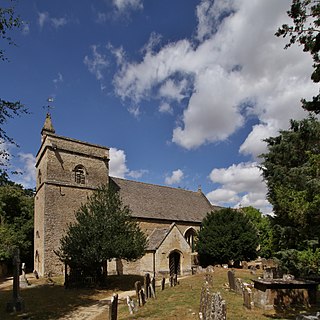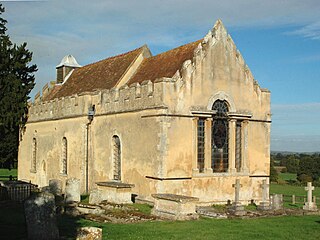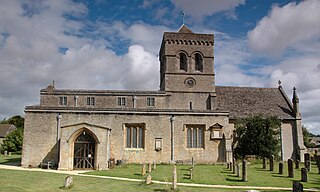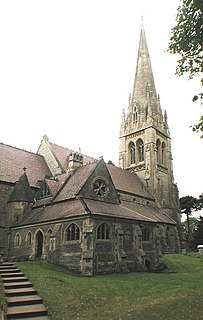
Bletchington Park is a Grade II* listed Palladian country house in Bletchingdon, Oxfordshire. [1]

Bletchington Park is a Grade II* listed Palladian country house in Bletchingdon, Oxfordshire. [1]
Bletchington's medieval manor house was rebuilt by Sir Thomas Coghill in about 1630. It was fortified and garrisoned by 200 Cavaliers under Colonel Francis Windebank during the First English Civil War, before being over-run by Roundheads during Cromwell's raid in 1644. [2] The Coghill family sold it to Lord Valentia in 1716.
The present house is a Palladian country house built in 1782 next to the parish church by James Lewis for Arthur Annesley, 5th Earl of Anglesey (also the 6th Viscount Valentia). [3] Bletchington village was originally built around a green, but the houses on the north side were pulled down when Bletchingdon Park was extended. [4]
The estate remained in the Valentia family until 1948, when Lord Valentia sold it to the Hon. William Astor, who resold it in 1953 to the Hon. Robin Cayzer, later Lord Rotherwick. [5] In 1993, the estate was bought by Dr. Michael Peagram, a chemicals industrialist and philanthropist, who had the house historically restored. In 2012, the 22,600-square-foot house was listed for sale at a price of 20 million pounds. [2]

Bletchingdon is a village and civil parish 2 miles (3 km) north of Kidlington and 6 miles (10 km) southwest of Bicester in Oxfordshire, England. Bletchingdon parish includes the hamlet of Enslow just over 1 mile (1.6 km) west of the village. The 2011 Census recorded the parish's population as 910.

Nuneham Courtenay is a village and civil parish about 5 miles (8 km) southeast of Oxford. It occupies a pronounced section of the left bank of the River Thames.

Wroxton is a village and civil parish in the north of Oxfordshire about 3 miles (5 km) west of Banbury. The 2011 Census recorded the parish's population as 546.

Hampton Poyle is a village in the Cherwell valley in Oxfordshire, England, about 1 mile (1.6 km) northeast of Kidlington and about 5 miles (8 km) north of the centre of Oxford. It is part of the civil parish of Hampton Gay and Poyle. Hampton Poyle was a separate civil parish of 807 acres (327 ha) until 1932, when it was merged with the neighbouring parish of Hampton Gay.

Wheatfield is a civil parish and deserted medieval village about 4 miles (6.4 km) south of Thame in Oxfordshire. Wheatfield's toponym is derived from the Old English for "white field", referring to the ripe crops that the Anglo-Saxons grew on its fertile land. Few of Wheatfield's buildings remain today except the Church of England parish church of Saint Andrew, the former rectory and the former outbuildings of the no-longer-standing manor house.

Kirtlington is a village and civil parish in Oxfordshire about 6+1⁄2 miles (10.5 km) west of Bicester. The parish includes the hamlet of Northbrook. The 2011 Census recorded the parish's population as 988. The parish measures nearly 3 miles (5 km) north–south and about 2+1⁄2 miles (4 km) east–west. It is bounded by the River Cherwell to the west, and elsewhere mostly by field boundaries. In 1959 its area was 3,582 acres (1,450 ha).

Christmas Common is a hamlet in Watlington civil parish, Oxfordshire about 7+1⁄2 miles (12 km) south of Thame in Oxfordshire, close to the boundary with Buckinghamshire. The hamlet is 812 feet (247 m) above sea level on an escarpment of the Chiltern Hills. Because of its elevation, Christmas Common has two radio masts that are prominent local landmarks.

Middleton Stoney is a village and civil parish about 2+1⁄2 miles (4 km) west of Bicester, Oxfordshire. The 2011 Census recorded the parish's population as 331. The parish measures about 2 miles (3 km) north–south and about 1+1⁄2 miles (2.4 km) east–west, and in 1959 its area was 1,853 acres (750 ha). Its eastern boundary is Gagle Brook, a tributary of the River Ray, and its western boundary is Aves ditch. It is bounded to the north and south by field boundaries.

Shipton-on-Cherwell is a village on the River Cherwell about 2 miles (3 km) north of Kidlington in Oxfordshire, England. The village is part of the civil parish of Shipton-on-Cherwell and Thrupp.

Weston-on-the-Green is a village and civil parish in the Cherwell district of Oxfordshire, England, about 4 miles (6 km) southwest of Bicester. The 2011 Census recorded the parish population as 523.
Glympton Park is a former deer park at Glympton, 3.5 miles (5.6 km) north of Woodstock, Oxfordshire, England. It includes Glympton House and has a 2,000 acres (810 ha) estate including the village of Glympton, its Norman parish church of St. Mary, 32 stone cottages and 167 acres (68 ha) of parkland.

Henry Woodyer (1816–1896) was an English architect, a pupil of William Butterfield and a disciple of A. W. N. Pugin and the Ecclesiologists.

Great Tew is an English village and civil parish in Oxfordshire, about 5 miles (8 km) north-east of Chipping Norton and 8 miles (13 km) south-west of Banbury. The 2011 Census gave a parish population of 156. This qualifies it for an annual parish meeting, not a monthly parish council. The village has largely belonged since the 1960s to the Johnston family, as the Great Tew Estate, with renovations and improvements. A news report in 2020 stated that David Beckham and Victoria Beckham owned a "£6m Great Tew country home", Maplewood Barn, formerly Park Barn. Great Tew had 87 Grade II listed buildings in 2021.

Tusmore is a settlement about 5+1⁄2 miles (9 km) north of Bicester in Oxfordshire. It is the location of the Tusmore country house and estate.

Little Faringdon is a village and civil parish in West Oxfordshire, about 1 mile (1.6 km) north of Lechlade in neighbouring Gloucestershire. The 2001 Census recorded its population as 63.

Charles Buckeridge was a British Gothic Revival architect who trained as a pupil of Sir George Gilbert Scott. He practised in Oxford 1856–68 and in London from 1869. He was made an Associate of the Royal Institute of British Architects in 1861.

William Wilkinson (1819–1901) was a British Gothic Revival architect who practised in Oxford, England.

Hardwick is a village in the civil parish of Hardwick with Tusmore about 4.5 miles (7 km) north of Bicester in Oxfordshire.

Rycote is a hamlet 2.5 miles (4.0 km) southwest of Thame in Oxfordshire. The Oxfordshire Way long-distance path passes through.

Middleton Park is a rural park in the parish of Middleton Stoney, Oxfordshire, England, about 2+1⁄2 miles (4 km) west of Bicester. The grounds are Grade II listed and include several historic buildings, notably a Grade I listed country house with Grade II* listed service wing and lodges.